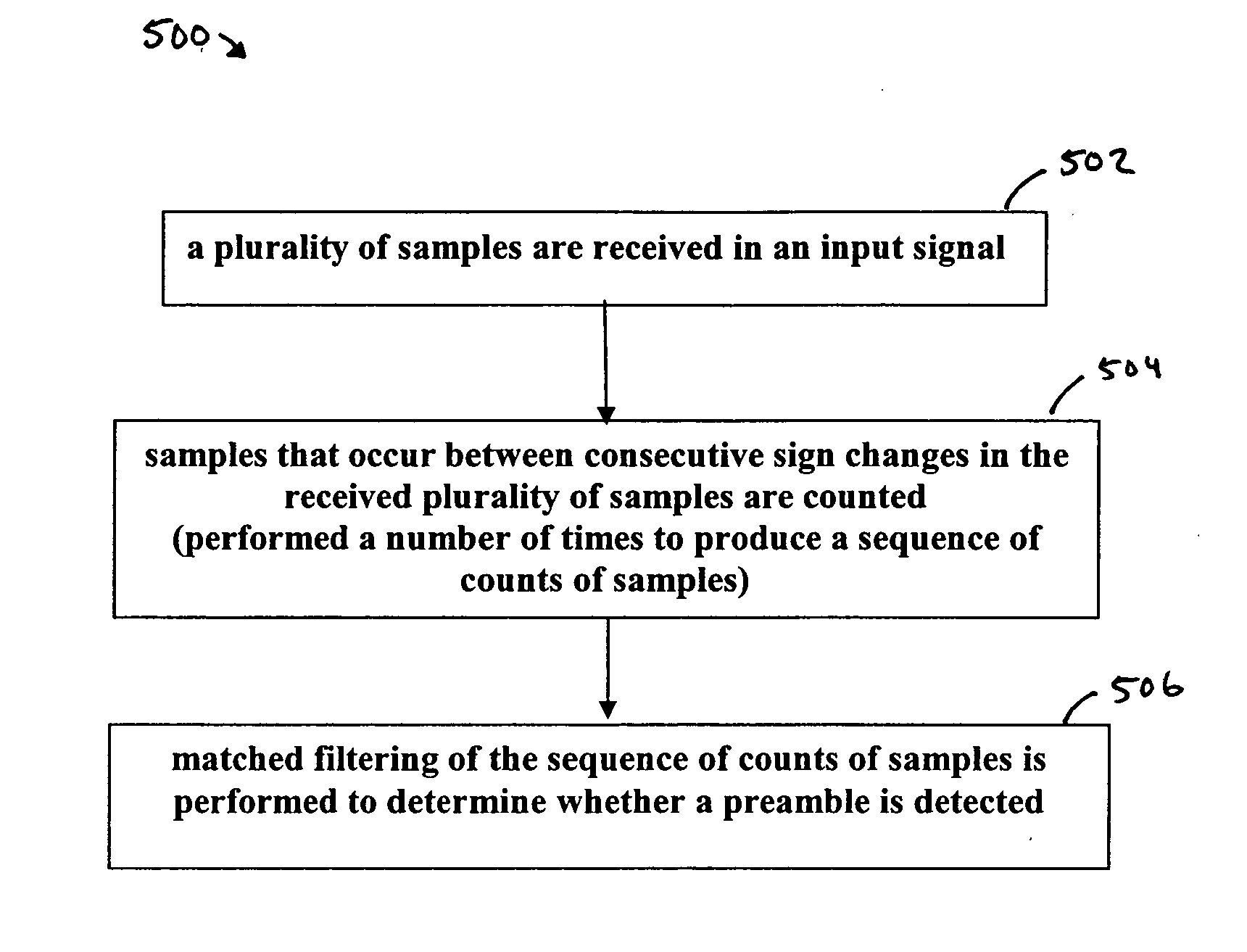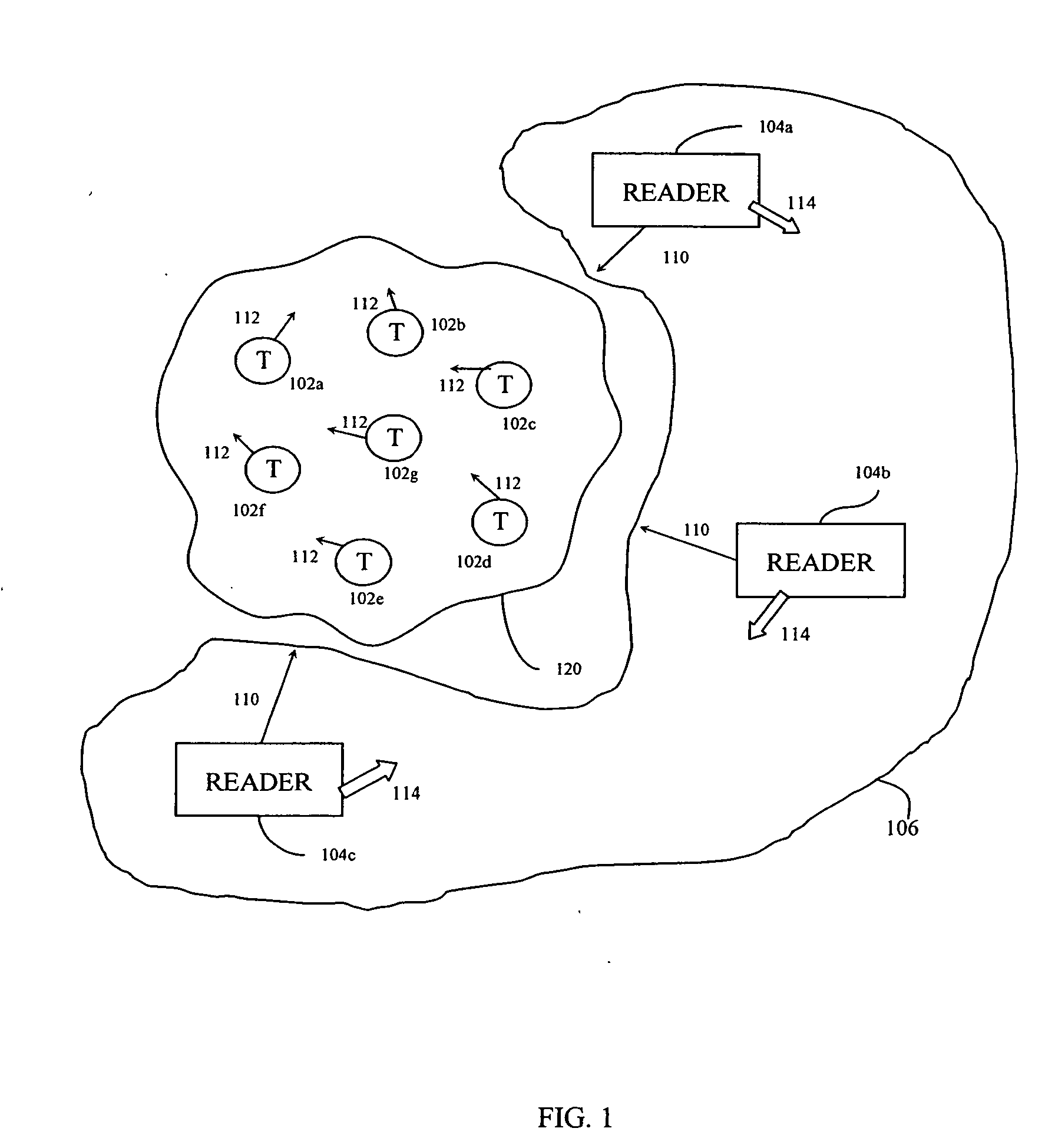Method and apparatus for preamble synchronization in wireless radio frequency identification (RFID) systems
a wireless radio frequency identification and preamble synchronization technology, applied in electrical equipment, digital transmission, time-division multiplex, etc., can solve the problems of reducing the probability of correctly decoding received data, multipath propagation, and severe interference of rfid communication channels, and achieve simple implementation and high performance.
- Summary
- Abstract
- Description
- Claims
- Application Information
AI Technical Summary
Benefits of technology
Problems solved by technology
Method used
Image
Examples
example rfid system embodiment
[0046] Before describing embodiments of the present invention in detail, it is helpful to describe an example RFID communications environment in which the invention may be implemented. FIG. 1 illustrates an environment 100 where RFID tag readers 104 communicate with an exemplary population 120 of RFID tags 102. As shown in FIG. 1, the population 120 of tags includes seven tags 102a-102g. According to embodiments of the present invention, a population 120 may include any number of tags 102.
[0047] Environment 100 includes either a single reader 104 or a plurality of readers 104, such as readers 104a-104c. In an embodiment, a reader 104 may be requested by an external application to address the population of tags 120. Alternatively, reader 104 may have internal logic that initiates communication, or may have a trigger mechanism that an operator of reader 104a uses to initiate communication.
[0048] As shown in FIG. 1, readers 104 transmit an interrogation signal 110 having a carrier fr...
reader embodiment
Example Conventional RFID Reader Embodiment
[0052]FIG. 2A shows an example block diagram of the receiver portion of a conventional RFID reader 200A. Reader 200A typically includes one or more antennas 204, one or more receivers 202, one or more transmitters, one or more memory units, and one or more processors (transmitters, memory units, and processors are not shown in FIG. 2A). As shown in the example of FIG. 2A, receiver 202 includes a RF front-end 205, a demodulator 206, and a decoder 208. These components of reader 200A may include software, hardware, and / or firmware, or any combination thereof, for performing their functions, which are described in further detail in subsequent sections herein.
[0053] Reader 200A has at least one antenna 204 for communicating with tags 102 and / or other readers 104. In an example FCC environment, interrogator transmission and tag responses are spectrally separated. A tag response signal includes data modulated according to an amplitude shift keyi...
example system embodiments
[0084] In embodiments, preamble detection systems can be configured to operate on one or more components of an input signal, such as I-phase and Q-phase components of an input signal. Thus, in an I / Q implementation, the I-phase and Q-phase components can both be processed in separate channels to detect the preamble of the input signal, and the results from one or both of the I-phase and Q-phase channels can be utilized as desired.
[0085]FIG. 7 shows an example preamble detection system 700 that can be implemented in the base-band portion of a receiver used in a wireless communication system, such as base-band portion 216. As shown in FIG. 7, system 700 includes an I-channel portion 702a and a Q-channel portion 702b. I-channel portion 702a includes a counter 704a, a matched filter 706a, a preamble detection flag register 708a, and a signal level detector 710a. Q-channel portion 702b includes a counter 704b, a matched filter 706b, a preamble detection flag register 708b, and a signal ...
PUM
 Login to View More
Login to View More Abstract
Description
Claims
Application Information
 Login to View More
Login to View More - R&D
- Intellectual Property
- Life Sciences
- Materials
- Tech Scout
- Unparalleled Data Quality
- Higher Quality Content
- 60% Fewer Hallucinations
Browse by: Latest US Patents, China's latest patents, Technical Efficacy Thesaurus, Application Domain, Technology Topic, Popular Technical Reports.
© 2025 PatSnap. All rights reserved.Legal|Privacy policy|Modern Slavery Act Transparency Statement|Sitemap|About US| Contact US: help@patsnap.com



